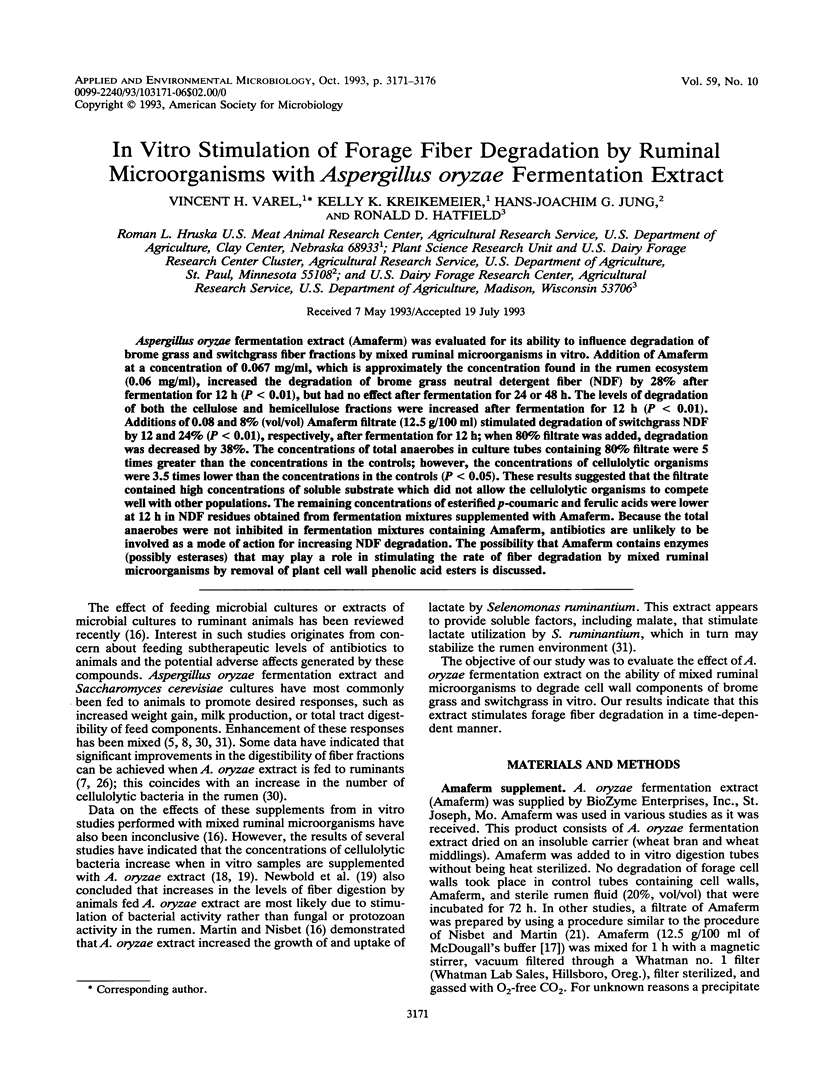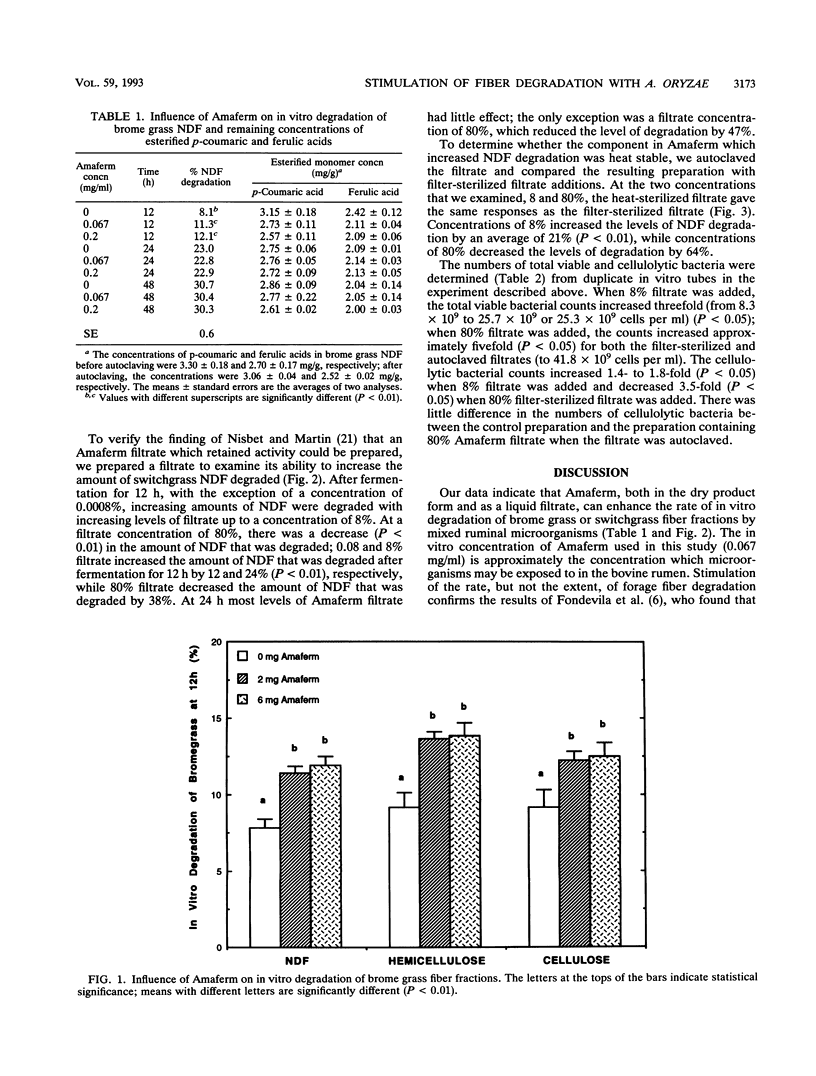Abstract
Aspergillus oryzae fermentation extract (Amaferm) was evaluated for its ability to influence degradation of brome grass and switchgrass fiber fractions by mixed ruminal microorganisms in vitro. Addition of Amaferm at a concentration of 0.067 mg/ml, which is approximately the concentration found in the rumen ecosystem (0.06 mg/ml), increased the degradation of brome grass neutral detergent fiber (NDF) by 28% after fermentation for 12 h (P < 0.01), but had no effect after fermentation for 24 or 48 h. The levels of degradation of both the cellulose and hemicellulose fractions were increased after fermentation for 12 h (P < 0.01). Additions of 0.08 and 8% (vol/vol) Amaferm filtrate (12.5 g/100 ml) stimulated degradation of switchgrass NDF by 12 and 24% (P < 0.01), respectively, after fermentation for 12 h; when 80% filtrate was added, degradation was decreased by 38%. The concentrations of total anaerobes in culture tubes containing 80% filtrate were 5 times greater than the concentrations in the controls; however, the concentrations of cellulolytic organisms were 3.5 times lower than the concentrations in the controls (P < 0.05). These results suggested that the filtrate contained high concentrations of soluble substrate which did not allow the cellulolytic organisms to compete well with other populations. The remaining concentrations of esterified p-coumaric and ferulic acids were lower at 12 h in NDF residues obtained from fermentation mixtures supplemented with Amaferm. Because the total anaerobes were not inhibited in fermentation mixtures containing Amaferm, antibiotics are unlikely to be involved as a mode of action for increasing NDF degradation. The possibility that Amaferm contains enzymes (possibly esterases) that may play a role in stimulating the rate of fiber degradation by mixed ruminal microorganisms by removal of plant cell wall phenolic acid esters is discussed.
Full text
PDF





Selected References
These references are in PubMed. This may not be the complete list of references from this article.
- Beharka A. A., Nagaraja T. G. Effect of Aspergillus oryzae fermentation extract (Amaferm) on in vitro fiber degradation. J Dairy Sci. 1993 Mar;76(3):812–818. doi: 10.3168/jds.s0022-0302(93)77405-6. [DOI] [PubMed] [Google Scholar]
- Borneman W. S., Ljungdahl L. G., Hartley R. D., Akin D. E. Purification and partial characterization of two feruloyl esterases from the anaerobic fungus Neocallimastix strain MC-2. Appl Environ Microbiol. 1992 Nov;58(11):3762–3766. doi: 10.1128/aem.58.11.3762-3766.1992. [DOI] [PMC free article] [PubMed] [Google Scholar]
- Bryant M. P. Commentary on the Hungate technique for culture of anaerobic bacteria. Am J Clin Nutr. 1972 Dec;25(12):1324–1328. doi: 10.1093/ajcn/25.12.1324. [DOI] [PubMed] [Google Scholar]
- Coutelle C., Brückner R., Grade K., Behrens F., Gedschold J., Hein J., Szibor R., Bauer I., Brock J., Graupner I. Prevalence of cystic fibrosis mutations in the East German population. Hum Mutat. 1992;1(2):109–112. doi: 10.1002/humu.1380010205. [DOI] [PubMed] [Google Scholar]
- Denigan M. E., Huber J. T., Alhadhrami G., al-Dehneh A. Influence of feeding varying levels of Amaferm on performance of lactating dairy cows. J Dairy Sci. 1992 Jun;75(6):1616–1621. doi: 10.3168/jds.s0022-0302(92)77918-1. [DOI] [PubMed] [Google Scholar]
- Gomez-Alarcon R. A., Dudas C., Huber J. T. Influence of cultures of Aspergillus oryzae on rumen and total tract digestibility of dietary components. J Dairy Sci. 1990 Mar;73(3):703–710. doi: 10.3168/jds.S0022-0302(90)78723-1. [DOI] [PubMed] [Google Scholar]
- Hatfield R. D., Helm R. F., Ralph J. Synthesis of methyl 5-O-trans-feruloyl-alpha-L-arabinofuranoside and its use as a substrate to assess feruloyl esterase activity. Anal Biochem. 1991 Apr;194(1):25–33. doi: 10.1016/0003-2697(91)90146-k. [DOI] [PubMed] [Google Scholar]
- Martin S. A., Nisbet D. J. Effect of direct-fed microbials on rumen microbial fermentation. J Dairy Sci. 1992 Jun;75(6):1736–1744. doi: 10.3168/jds.S0022-0302(92)77932-6. [DOI] [PubMed] [Google Scholar]
- McDougall E. I. Studies on ruminant saliva. 1. The composition and output of sheep's saliva. Biochem J. 1948;43(1):99–109. [PMC free article] [PubMed] [Google Scholar]
- Nisbet D. J., Martin S. A. Effect of Dicarboxylic Acids and Aspergillus oryzae Fermentation Extract on Lactate Uptake by the Ruminal Bacterium Selenomonas ruminantium. Appl Environ Microbiol. 1990 Nov;56(11):3515–3518. doi: 10.1128/aem.56.11.3515-3518.1990. [DOI] [PMC free article] [PubMed] [Google Scholar]
- Salanitro J. P., Fairchilds I. G., Zgornicki Y. D. Isolation, culture characteristics, and identification of anaerobic bacteria from the chicken cecum. Appl Microbiol. 1974 Apr;27(4):678–687. doi: 10.1128/am.27.4.678-687.1974. [DOI] [PMC free article] [PubMed] [Google Scholar]
- Van Soest P. J., Robertson J. B., Lewis B. A. Methods for dietary fiber, neutral detergent fiber, and nonstarch polysaccharides in relation to animal nutrition. J Dairy Sci. 1991 Oct;74(10):3583–3597. doi: 10.3168/jds.S0022-0302(91)78551-2. [DOI] [PubMed] [Google Scholar]
- Varel V. H., Jung H. G., Krumholz L. R. Degradation of cellulose and forage fiber fractions by ruminal cellulolytic bacteria alone and in coculture with phenolic monomer-degrading bacteria. J Anim Sci. 1991 Dec;69(12):4993–5000. doi: 10.2527/1991.69124993x. [DOI] [PubMed] [Google Scholar]
- Wiedmeier R. D., Arambel M. J., Walters J. L. Effect of yeast culture and Aspergillus oryzae fermentation extract on ruminal characteristics and nutrient digestibility. J Dairy Sci. 1987 Oct;70(10):2063–2068. doi: 10.3168/jds.S0022-0302(87)80254-0. [DOI] [PubMed] [Google Scholar]


